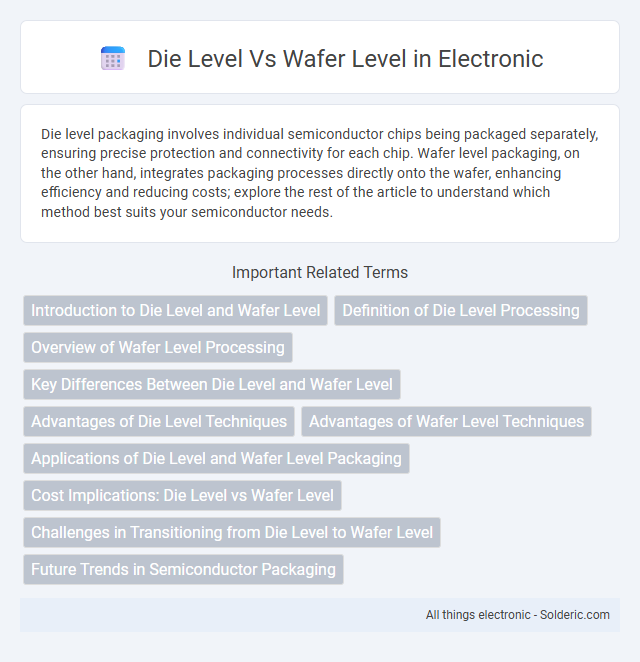Die level packaging involves individual semiconductor chips being packaged separately, ensuring precise protection and connectivity for each chip. Wafer level packaging, on the other hand, integrates packaging processes directly onto the wafer, enhancing efficiency and reducing costs; explore the rest of the article to understand which method best suits your semiconductor needs.
Comparison Table
| Aspect | Die Level Packaging | Wafer Level Packaging |
|---|---|---|
| Definition | Packaging performed on individual semiconductor dies. | Packaging executed while dies are still in wafer form. |
| Process Stage | Post wafer dicing. | Pre wafer dicing. |
| Cost Efficiency | Higher per unit cost due to individual handling. | Lower cost via batch processing of entire wafer. |
| Size & Form Factor | Generally larger package size. | Allows for smaller, thinner packages. |
| Throughput | Lower throughput due to handling individual dies. | Higher throughput with parallel wafer processing. |
| Reliability | Established, mature process with proven reliability. | Improved electrical performance; process maturity varies. |
| Applications | Used in traditional packaging and complex heterogenous integration. | Ideal for high volume, cost-sensitive applications like mobile devices. |
Introduction to Die Level and Wafer Level
Die Level packaging involves assembling and testing individual semiconductor dies separately, providing flexibility for customization and varying device sizes. Wafer Level packaging integrates packaging processes directly on the wafer before dicing, enhancing throughput and reducing costs for high-volume production. Your choice between die level and wafer level depends on factors like device application, cost constraints, and manufacturing scalability.
Definition of Die Level Processing
Die level processing involves handling and testing individual semiconductor dies after they are separated from the wafer, allowing for precise quality control and packaging at the single-chip scale. This method contrasts with wafer level processing, which performs tests and packaging steps on the entire wafer before dicing. Die level processing is critical for ensuring the functionality and reliability of each integrated circuit in complex manufacturing workflows.
Overview of Wafer Level Processing
Wafer level processing involves manufacturing and testing semiconductor devices directly on the wafer before dicing into individual die, enabling higher throughput and improved yield compared to traditional die-level processing. This approach integrates packaging and testing steps on the wafer scale, reducing handling risks and enhancing precision in alignment and bonding. Your production efficiency can significantly increase by adopting wafer level techniques, which streamline fabrication and deliver cost-effective, miniaturized semiconductor components.
Key Differences Between Die Level and Wafer Level
Die level packaging involves individual semiconductor chips being packaged separately after wafer dicing, allowing for customized package types tailored to specific applications. Wafer level packaging integrates the packaging process directly on the wafer before dicing, enhancing throughput and reducing package size by avoiding handling of individual dies. Key differences include process timing, scalability, cost efficiency, and resulting package form factors, with wafer level packaging offering superior miniaturization and performance for high-volume production.
Advantages of Die Level Techniques
Die level techniques enable precise testing and packaging of individual semiconductor dies, improving yield by isolating and addressing defects early in the production process. These methods offer enhanced flexibility in customizing packaging solutions tailored to specific die characteristics and performance requirements. By facilitating detailed electrical testing at the die stage, die level approaches reduce material waste and overall manufacturing costs compared to wafer level processes.
Advantages of Wafer Level Techniques
Wafer level techniques offer significant advantages over traditional die level packaging by enabling higher throughput and lower costs through batch processing of multiple devices on a single wafer. These methods enhance device reliability and performance by reducing interconnect length and parasitic effects, while also enabling finer pitch and smaller form factors suitable for advanced applications. Your production efficiency improves as wafer level packaging supports seamless integration with automated inspection, alignment, and testing processes, minimizing handling and potential damage.
Applications of Die Level and Wafer Level Packaging
Die level packaging is predominantly used in applications requiring high-performance and customization, such as advanced microprocessors and discrete semiconductor devices, where precise electrical and thermal management is critical. Wafer level packaging finds extensive application in consumer electronics, including smartphones, IoT devices, and wearable technology, due to its cost-effectiveness, miniaturization benefits, and mass production capability. Both packaging methods optimize device integration but target different industry needs based on scale, performance, and economic factors.
Cost Implications: Die Level vs Wafer Level
Die level packaging often incurs higher costs due to individual handling and testing of each die, which increases labor and equipment expenses. Wafer level packaging reduces overall costs by allowing simultaneous processing of multiple dies on a wafer, optimizing material usage and minimizing assembly time. Your choice between die level and wafer level packaging significantly impacts manufacturing budgets, with wafer level providing more cost-effective solutions for high-volume semiconductor production.
Challenges in Transitioning from Die Level to Wafer Level
Transitioning from die level packaging to wafer level packaging presents significant challenges including maintaining yield consistency across entire wafers and managing smaller feature sizes that increase defect risks. Process integration complexities arise due to the need for advanced lithography and bonding techniques to ensure precise alignment and electrical connectivity at wafer scale. Additionally, thermal management becomes critical as wafer level packages demand efficient heat dissipation to prevent performance degradation and reliability issues.
Future Trends in Semiconductor Packaging
Die level packaging offers precise control and customization for individual chips, while wafer level packaging enables cost-effective mass production by processing entire wafers simultaneously. Future trends emphasize increased integration, such as through-silicon vias (TSVs) and fan-out wafer-level packaging (FOWLP), which enhance performance, reduce size, and improve thermal management. Your choice between die level and wafer level approaches will impact scalability and the ability to meet evolving demands for smaller, faster, and more energy-efficient semiconductor devices.
Die Level vs Wafer Level Infographic

 solderic.com
solderic.com